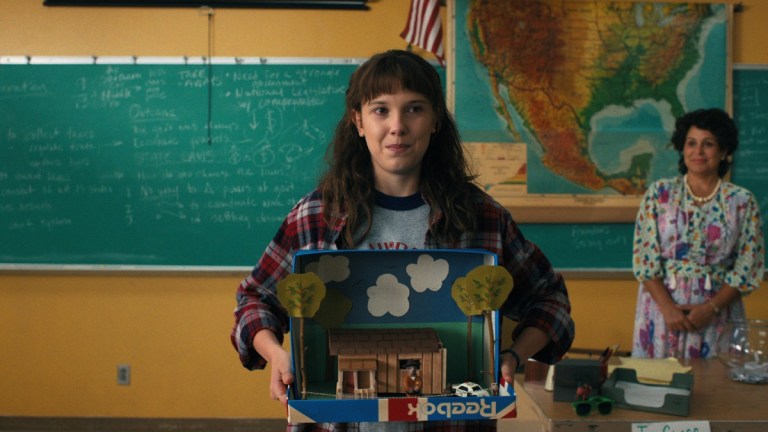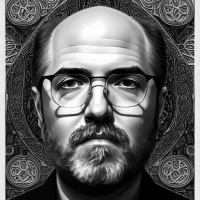How Stranger Things Keeps Its Cast (And Crew) Young
Shawn Levy shares how the “wonderment of childhood” and ’80s pop culture continue to thrive in Stranger Things season 4.

Throughout its run on Netflix, Stranger Things has celebrated the relationships of its young protagonists. Their bonds were strengthened through the shared trauma and triumph of fighting creatures from another dimension and the careless government agencies that enabled them to enter our world. But the story succeeds largely because of its 1980s setting, which not only provides a Cold War rationale for the adults’ behavior but also gives the teen heroes a certain pre-internet innocence that appeals to people who grew up in that decade and to those who appreciate the pop culture of the era.
Brothers Matt and Ross Duffer started a nostalgia trend when they created Stranger Things in 2016, and their fellow producer and director Shawn Levy has brought their vision to life with a family appeal befitting his filmography, which includes the Night at the Museum movies and, more recently, The Adam Project and Free Guy. Their knack for tapping into the ’80s zeitgeist has been largely responsible for launching the careers of their young stars, including Millie Bobby Brown, Finn Wolfhard, Joe Keery, Sadie Sink, and others.
Levy admits that’s why Stranger Things has enjoyed recontextualizing ’80s actors such as Matthew Modine in season one, Sean Astin in season two, and Cary Elwes in season three, not to mention lead actress Winona Ryder.
“I was a tween and a teen in the ’80s, so these are cultural, historical touchstones for me,” says Levy. “Though I confess, the Duffers, who weirdly were born in the ’80s, have even more nerd nostalgia affinity for a lot of these touchstones.”
In season four, the reinvented ’80s actor is Robert Englund—best known for his role as Freddy Krueger in the A Nightmare on Elm Street movies—who will play Victor Creel, a disturbed man accused of a terrible murder in 1950s Hawkins.
“I had the good fortune of directing Robert in some of his stuff for this season, and the only thing more fun than meeting and working with Robert was watching the Duffers meet and chat with Robert,” says Levy. “In fact, as I recall it, Matt Duffer came to meet Robert with a Nightmare on Elm Street t-shirt on. That’s what beautiful, gorgeous nerds the Duffer brothers are.”
Dungeons & Dragons, a popular pastime of the ’70s and ’80s, has also played a key role in Stranger Things, providing contextual names for the show’s supernatural creatures. The Demogorgon gave way to the Mind Flayer, and season four will introduce Vecna, a name straight out of the D&D Monster Manual.
“I think it’s such an interesting early decision that we made on the show to give these names to our supernatural characters and phenomena that we don’t claim to have made up,” Levy says. “It’s literally our characters in the world of the show finding language for the crazy stuff that is going on in Hawkins.”
Levy is aware that Stranger Things is often accused of over-indulging in nods to ’80s pop culture, but, since these days, more people are likely to associate the term “Demogorgon” with the show than with D&D, they can hardly be blamed for continuing the tradition.
“I love the meta level of the fact that even the characters in Stranger Things use cultural references to understand the supernatural occurrences,” Levy enthuses. “And Vecna is a significant one both in D&D lore but also in what’s about to be Stranger Things lore. It’s literally these words that people think we made up… but no, it’s characters in Stranger Things appropriating the lexicon of D&D.”
The show’s fourth season adds an emotional twist by separating the friends who have battled the forces of the Upside Down at a crucial time in any teenager’s life: right at the start of high school.
“As I think we knew, Joyce moved away with Will and Jonathan, and Eleven moved with them,” Levy says. “We all remember that tearful farewell at the end of season three, so they’re all now living in Lenora, California… and things never quite seem to stay stable for as long as we’d like in good old fictional Hawkins, Indiana.”
This time, there’s plenty for each group to worry about besides other-dimensional beings and government conspiracies.
“Clearly, there is an attempt by the characters to find new places in the world: geographical places, social places, hierarchical places in the new social sphere of high school,” says Levy. “These are struggles and aspirations that all of us relate to, all of us have gone through. Whether we call B.S. on it or we play by those rules, adolescence is a time of finding yourself, and so much of how we flail in our attempt to find ourselves is the way we locate our identity among others.”
Levy notes that this struggle has been taking place in the background of every season of Stranger Things, underpinning the supernatural battle. “
I’d say that one of the core themes of season four is one of the core themes of the franchise and all seasons, which is you can try to define yourself by someone else’s rules, but the only friendships and authentic identity you’re ever going to be able to hold on to are the ones that are authentic to you and aren’t looking outside yourself for meaning and positioning,” Levy says.
Complicating the high school frame of reference is the fact that the actors have aged significantly beyond the three-year scope of the show’s current timeline, but that doesn’t keep the cast from regressing to their younger selves as soon as they hit the set.
“The [childlike joy] that happens when these kids are reunited with each other is adorable,” says Levy. “These are friends who met each other when they were 11 and 12, and as we all know, those kinds of bonds don’t really evolve and mature that much. They are always right there, immature and beautiful, right below the surface. So there is a really nice kind of familial connection.”
Recapturing childhood, even for those who didn’t grow up in the ’80s, is a crucial ingredient of Stranger Things, with its Spielberg-esque sense of adventure that audiences associate with the entertainment of that decade.
“I have always firmly believed that our kid-self is right there with us, and I think that’s a beautiful fact of humanity,” says Levy. “The bittersweet relationship that we have with innocence and with our childhood selves is at the heart of so much of Spielberg’s work; it’s at the heart of so many of my movies and very much at the core of Stranger Things.”
Young audiences already possess that sense of adventure, but adults also want to re-capture it by watching Stranger Things, both for the horror and the fun.
“People always ask me, ‘What’s the secret? Why is Stranger Things so successful?’” says Levy. “I know that people think it’s the genre tropes and the darkness, but I know it’s the balance between darkness and light, between scares and wonder. The wonderment of childhood is at the beating heart center of Stranger Things, and I think that’s why we love this world in such an enduring way.”
Stranger Things Season 4 Volume 1 arrives on Netflix on May 27. Volume 2 will land on July 1.
